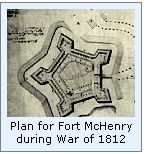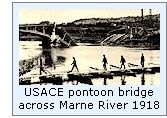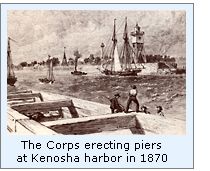 The roots of the Corps. The roots of the Corps.
The Corps of Engineers plays a proud and integral part in both US military and Civil engineering history, and traces its' roots to the very founding of the United States itself.
Four years later, Congress followed-up
to create a Corps of "Sappers and Miners," who were to play a
pivotal role in the preparation of defenses around such strategic points
as Bunker Hill and Yorktown. Originally largely staffed with French
instructors, the Academy was patterned after "L'Ecole Polytechnique"
in Paris. The Academy produced officers who were capable of applying
their knowledge to military engineering as well as much needed nation
building for the ever expanding United States. The Corps continued to
maintain responsibility for the West Point Academy through the end of
the Civil War, when admission to the Academy was opened-up to all
branches of the Military and administration of the facility was
transferred to Secretary of War.
In 1847 at the Battle of Contreras during Mexican War, Corps Lieutenant Gustavus W. Smith and his company received permission to participate in the attack. In fact, Smith and his company lead the assault. The next morning, the Engineer Company attacked the Mexican forces from the rear, causing them to flee. In 1862 at Fredericksburg, the Corps laid six pontoon bridges across the Rapahannock River under devastating fire from Confederate sharpshooters. Army Engineers were the first U.S. soldiers sent to Europe during World War I. The 11th Engineer Regiment suffered the first U.S. casualties of the war while working to clear a passage through no-man's land in France. In 1918, two 6th Engineer companies ceased their construction of heavy steel bridges to join British and Canadian troops in the trenches, where they suffered seventy-seven casualties successfully defending Amiens from a heavy German assault.
In Korea, Engineer soldiers frequently found themselves trapped behind enemy lines and fighting as infantry. In Vietnam, Engineers soldiers rappelled from helicopters into enemy controlled jungle areas to blast landing zones for infantry assaults. From the beginning of US military history, the Corps of Engineers has been an integral force, and while the Corps' service is legendary, it is perhaps for it's peacetime contributions that the impact of the Corps is most immediately felt by the vast majority of Americans. The Corps
converts to peacetime operations At various times, the Corps has been utilized in such diverse areas as construction of the National Road, navigation improvements on the Ohio and Mississippi Rivers, dam construction, exploration and survey, supervision of construction of the Panama Canal, domestic inland waterway development.
With the establishment of the Lighthouse Board in 1852, three engineer officers were installed as members of the original Board. Engineer officers continued to serve as board members and district lighthouse inspectors until Congress abolished the Lighthouse Board in 1910. As a result, during the latter half of the nineteenth century, engineer officers designed lighthouses to help mariners weather violent storms, and played a major part in the improvement of the United States aids to navigation system, including the incorporation of screw-pile technology in lighthouse construction. The Corps
involvement in the
Western Great Lakes The district's primary mission is to investigate, plan, design, construct, operate and maintain Congressionally authorized water resource projects related to navigation, flood control and beach erosion. Responsibility for operation and maintenance of the Soo Locks and one hundred and two harbors on Lakes Superior, Michigan, Huron, St. Clair and the State of Michigan portion of Lake Erie.
All told, the Detroit District is responsible for 68 commercial harbors, 71 recreational harbors, 734 miles of navigation channel, 150 miles of breakwater, 25 lock chambers, 44 dredged material confined disposal facilities, and 3 visitor centers. The operation and maintenance of this navigation system involves a number of activities, including: mapping and surveys, operation of locks, maintenance and repair of breakwaters and jetties, dredging of navigation channels, and the operation of visitor's centers. The Detroit District also manages the Great Lakes Water Control Data System, making it the Corps center for hydrometeorology and water level data collection and dissemination for the Great Lakes system, something that has become an area for considerable increased concern with recently falling water levels throughout the Great Lakes.
By way of example, in order to maintain
navigable water depths throughout Milwaukee Harbor, the Eighth District
dispatched |
 Realizing
that the coming war was to be one of a defensive nature, a mere two days
after forming the United States Army on June 14, 1775, Congress created
the position of "Chief Engineer for the Army." General George
Washington himself selected Colonel Richard Gridley as the first to fill
the position. General Washington realized that the coming revolutionary
war with England would, by definition be one of a defensive nature.
Faced with a lack of qualified military engineers within the populace,
Washington pleaded with Congress to find a way to provide him with the
necessary technical support. Congress was forced to turn to France, a
long-term enemy of England, and the current center of state-of the art
siege craft and fortification design. Thus, the French, were entreated
to provide the necessary technical support.
Realizing
that the coming war was to be one of a defensive nature, a mere two days
after forming the United States Army on June 14, 1775, Congress created
the position of "Chief Engineer for the Army." General George
Washington himself selected Colonel Richard Gridley as the first to fill
the position. General Washington realized that the coming revolutionary
war with England would, by definition be one of a defensive nature.
Faced with a lack of qualified military engineers within the populace,
Washington pleaded with Congress to find a way to provide him with the
necessary technical support. Congress was forced to turn to France, a
long-term enemy of England, and the current center of state-of the art
siege craft and fortification design. Thus, the French, were entreated
to provide the necessary technical support. Congress realized that a continued lack of qualified American military
engineers represented a critical strategic liability. In order to
institute a long-term corrective solution, on July 4, 1802, Congress
authorized the President to organize and establish a Corps of Engineers,
to be based in West Point, where they were charged with the
establishment and long-term operation of a Military Academy.
Congress realized that a continued lack of qualified American military
engineers represented a critical strategic liability. In order to
institute a long-term corrective solution, on July 4, 1802, Congress
authorized the President to organize and establish a Corps of Engineers,
to be based in West Point, where they were charged with the
establishment and long-term operation of a Military Academy. At Yorktown in October 1781, the Corps
team of thirteen Engineer Officers performed crucial reconnaissance, and
working in concert with fifty Sappers and Miners, assembled fortified
positions, erected gun platforms, transported cannon and ammunition, and
cleared the way for a decisive victory.
At Yorktown in October 1781, the Corps
team of thirteen Engineer Officers performed crucial reconnaissance, and
working in concert with fifty Sappers and Miners, assembled fortified
positions, erected gun platforms, transported cannon and ammunition, and
cleared the way for a decisive victory. General Douglas Macarthur described
World War II as "an Engineer's War." In fact, Engineers were
first on the beach at Normandy where they were dispatched to clear
obstacles. The Corps captured the bridge at Remagen, built the 1,500
mile ALCAN highway through frozen tundra in Alaska, constructed the Ledo
road through 438 miles of jungle to link Burma and India, and erected
camps for 5.3 million troops. Corps Engineers oversaw the conversion of
factories to produce ammunition and tanks, a huge network of ports,
bomber bases, hospitals with 1/2 million beds, and even the design and
construction of the Pentagon, to consolidate the War Department's
command and control of our armed forces.
General Douglas Macarthur described
World War II as "an Engineer's War." In fact, Engineers were
first on the beach at Normandy where they were dispatched to clear
obstacles. The Corps captured the bridge at Remagen, built the 1,500
mile ALCAN highway through frozen tundra in Alaska, constructed the Ledo
road through 438 miles of jungle to link Burma and India, and erected
camps for 5.3 million troops. Corps Engineers oversaw the conversion of
factories to produce ammunition and tanks, a huge network of ports,
bomber bases, hospitals with 1/2 million beds, and even the design and
construction of the Pentagon, to consolidate the War Department's
command and control of our armed forces. The Corps has also been involved in the
construction of the Library of Congress and Washington monument,
management of the D.C. park system, flood control, and the construction
of the majority of the structures used in the US space program. In fact,
the Corps been involved in so many peacetime projects that an entire
website could be dedicated to a listing of their accomplishments.
The Corps has also been involved in the
construction of the Library of Congress and Washington monument,
management of the D.C. park system, flood control, and the construction
of the majority of the structures used in the US space program. In fact,
the Corps been involved in so many peacetime projects that an entire
website could be dedicated to a listing of their accomplishments.
 The Army Corps of Engineers Detroit
District was established in 1841, and maintains responsibility for
82,000 square miles of land containing approximately 4,000 miles of
Great Lakes shoreline. In order to oversee these responsibilities over
such a wide area of responsibility, in addition to the main district
facilities in Detroit, four area offices are maintained in Duluth,
Kewaunee, Grand Haven & Sault Ste. Marie
The Army Corps of Engineers Detroit
District was established in 1841, and maintains responsibility for
82,000 square miles of land containing approximately 4,000 miles of
Great Lakes shoreline. In order to oversee these responsibilities over
such a wide area of responsibility, in addition to the main district
facilities in Detroit, four area offices are maintained in Duluth,
Kewaunee, Grand Haven & Sault Ste. Marie
 Total annual commerce on the Great
Lakes averages 175.3 million tons, with 86.2 million tons passing
through the
Total annual commerce on the Great
Lakes averages 175.3 million tons, with 86.2 million tons passing
through the  Dredging and the management of dredged
material are an important function of the Corps Eighth district.
Typically, about 4 million cubic yards of sediments are dredged by the
Corps of Engineers each year from Great Lakes harbors and channels. This
is equivalent to 400,000 truck loads of soil. This may seem large, but
is actually only a small piece of the 300-350 million cubic yards
dredged by the Corps nationwide annually. On average, the Corps of
Engineers spends about $20 million dollars annually for dredging and
dredged material management in the Great Lakes Basin.
Dredging and the management of dredged
material are an important function of the Corps Eighth district.
Typically, about 4 million cubic yards of sediments are dredged by the
Corps of Engineers each year from Great Lakes harbors and channels. This
is equivalent to 400,000 truck loads of soil. This may seem large, but
is actually only a small piece of the 300-350 million cubic yards
dredged by the Corps nationwide annually. On average, the Corps of
Engineers spends about $20 million dollars annually for dredging and
dredged material management in the Great Lakes Basin.